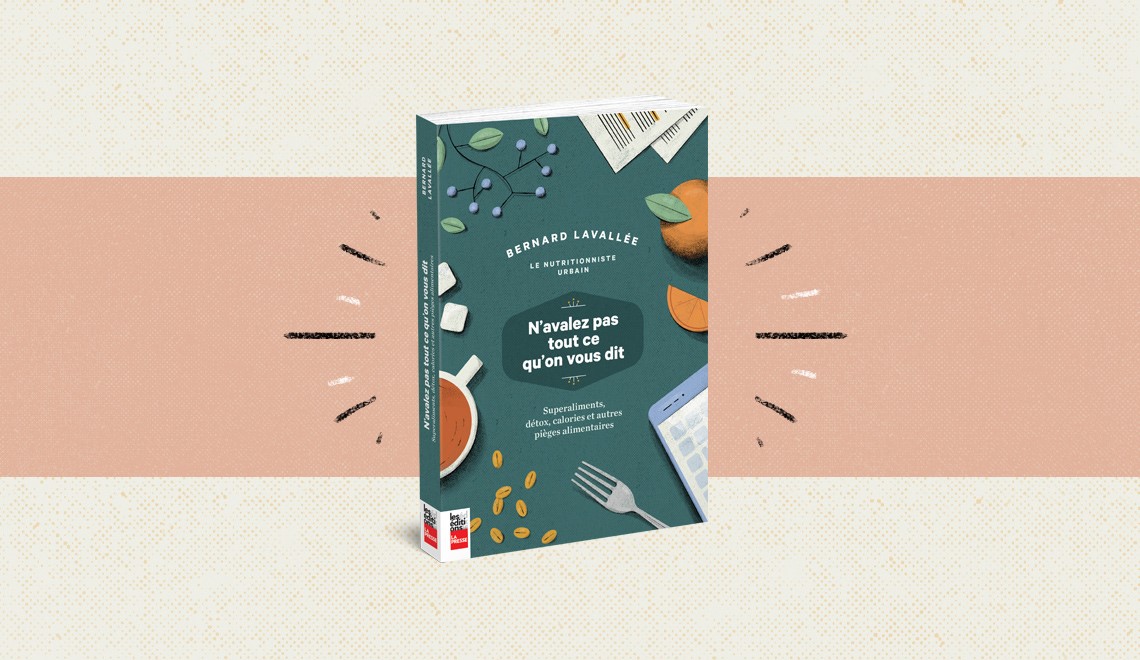Gluten-free, low in fat, high in fiber. Super food, trans fat free, high source of omega 3. Every day we face a multitude of nutrition tips. But what do we really understand about this wealth of information?
In the book N’avalez pas ce qu’on vous dit, the Nutritionniste urbain (Urban Nutritionist) demystifies the pitfalls of the agri-food industry and provides tools for a balanced nutrition while better understanding the current food context.
INTERVIEW
1) N’avalez pas ce qu’on vous dit opens up with a powerful first chapter tackling the “nutritional bullshit”. What is “nutritional bullshit”?
It is nutrition-related information that can either be false or partly true (based on science, but with some invention) or science-based (with data to prove it, but without any real influence on our lives).
For example, we heard in the news that blueberries were a weapon against cancer. If we do more research, we realize that the studies have tested the effects of blueberry juice on mice in the laboratory. However, results observed in animals cannot be applied as is to humans. This is called “nutritional bullshit”.
2) How can the informed consumer sort through the amount of information available to him when he visits the supermarket?
Currently, to boost sales nutritional marketing is used on one in two products with packaging. The industry uses nutrition-related terms such as “high in fiber”, “rich in antioxidants”, “gluten free”, “low in fat”, “low in calories” to make us believe their products are better for us than they really are.
The industry’s ultra-processed products such as potato chips, cereal bars, cookies and soft drinks have, for the most part, a list of similar ingredients: fat, sugar, salt, refined flours and additives. Since these ingredients are of little nutritional value and also have a detrimental effect on our health when consumed too much, the industry tries to convince the consumer to buy their product by crediting it with non-existent benefits. This is called “nutritional marketing”.
To make an informed choice without falling into traps, I recommend the following five tips:
- Prioritize unpackaged foods:
Food without packaging is generally the most beneficial for our health. Fruits and vegetables do not have packaging to advertise their properties but they are excellent for our health.
- Avoid foods with health claims
The benefits promised in these health claims are rarely met.
- Favour foods with a very short ingredient list
Choose foods with 5 ingredients or less. Of course, there are exceptions, but this is a quick and effective way to recognize the good from the bad.
- Avoid foods with artificial ingredients in the list
Artificial ingredients are not automatically bad for your health, but they can give us an idea of the level of product processing.
- Avoid food with a character on the package
Foods with this type of packaging are mostly intended for children and are designed as promotional items. The nutritional value of this type of product is often very poor.
These 5 tips will help you make smart supermarket choices quickly and easily, without having to refer to nutrients and calories.
3) Why do scientific studies on nutrition often contradict each other?
Science is a tool that seeks to strive for truth. Millions of nutritional studies are published each year, and each represents a piece of the big nutrition puzzle. From a scientific point of view, it is normal to get divergent answers, since we analyze different dimensions of a given question. That is how the scientific process works. As a consumer, it is not these numerous puzzle pieces that should interest us: they should not have any influence on our eating habits. What we want to understand is the overall picture: generally speaking, in which direction are the findings in nutritional research pointing? The media tend to focus on one piece of the puzzle to make it into a generality, giving the impression that nutritional research is contradictory. In reality, this puzzle piece should not interest us; it is not representative of the overall picture.
4) You mention in your book that you prefer the Brazilian Food Guide to Canada’s Food Guide. What is the reason for that?
Canada’s current Food Guide dates back to 2007, but its philosophy goes back to the wartime period of the 1940s. In this wartime period, nutritional deficiencies were much more frequent in the population. The purpose of the Food Guide at the time was to make people aware of the need and importance to eat enough nutrients.
Today, Canada’s Food Guide is still aimed at preventing nutritional deficiencies, despite the fact that the current nutritional context is quite different. In 2018, the nutritional problems that plague the population no longer concern deficiencies, but rather the problems of obesity, chronic diseases such as diabetes, cancer and cardiovascular diseases. We are in an era of food abundance, but the food we have access to is often processed. It is this specific problem that should concern us.
The Brazilian Food Guide, on the other hand, responds to the nutritional context of the 21st century by tackling food processing. It advises the public to prioritize unprocessed foods by proposing different procedures to follow, such as cooking more often, allowing more time to prepare food, eating with the family, favouring farmers markets where more fresh produce is sold than processed products.
I expect that Canada’s new Food Guide (planned for 2018) will be inspired by this model, which is more responsive to the public health issues of our time.
5) Are there different levels of food processing?
Absolutely. To evaluate the level of food processing, I rely on the NOVA classification, which distinguishes four food groups according to their degree of processing.
- Category 1: Fresh food – slightly processed
Fruits, vegetables, meat, milk; food originating from the earth or animals.
- Category 2: Culinary products
Sugar, salt and fat
- Category 3: Processed food
Bread, canned foods (vegetables, legumes, etc.), pasta, yogurt, cheese.
* This category doesn’t necessarily need to be reduced in our diet.
- Category 4: Ultra-processed food
These are foods that contain a lot of sugar, salt, fat and additives. We are talking cookies, cereal bars, cereals, cakes, soft drinks, yogurt with candy, chocolates. These are the foods we should limit as much as possible in our diet.
6) Food can be a cause of stress for some people, even though it should – above all – be a source of pleasure. Do you have any tips for eating a balanced diet without feeling guilty?
For me, eating a balanced diet means eating in a relatively healthy way: drinking mostly water; eating mostly plant-based (fruits, vegetables, grain products, nuts, seeds); eating as little processed food as possible; eating a variety of foods. Healthy eating also means considering the notion of pleasure in the search for balance.
To learn more about Bernard Lavallée, click here.
YOU MAY ALSO LIKE THESE ARTICLES
Yoga and coaching: two complementary methods to regain balance




